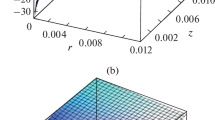Abstract
Based on the previously developed model of thermal, electromagnetic, and structural-phase processes in surface layers of carbon steels under the action of high-frequency pulses, the heat release in these layers in the range of allowable field frequencies from 66 kHz to 40.12 MHz is studied. The specific energy flux of the electromagnetic field is considered as the basic energy parameter characterizing the intensity of high-frequency treatment. Frequency dependences of the dynamics of steel heating up to the liquidus point for treatment regimes important for practice with 〈W〉 = 108 and 2 · 108 W/m2 for the width of the pulse-action zone on the steel surface equal to 1.5 and 4 mm are obtained. The data of numerical calculations are used to construct the specific flux of energy as a function of the maximum surface temperature; together with the results of numerical simulations of structural-phase transformations in the steel grain, these dependences allow one to choose the optimal hardening modes at different frequencies.
Similar content being viewed by others
REFERENCES
A. B. Kuvaldin, Theory of Induction and Dielectric Heating [in Russian], Izd. Mosk. Énerg. Inst., Moscow (1999).
G. Stahli, "Kurzzeit-Warmbehandlung," Harter.-Techn. Mitt., 39, 81-138 (1984).
D. Hinneberg, "Das HF-Impulsharten und Seine Einsatzgebiete," Draht, 43, 1000-1002 (1992).
"Nicht tief, aber hart," Schweizer Maschinenmarkt, 92, 170-173 (1992).
"HF-Impulsharten," Harter.-Techn. Mitt., 48, A43 (1993).
G. Ploger, "HF-Impulsharten-ein innovatives ober achenharteverfahren," Elektrowarme Intern. B, 51, No. 3, 110-112 (1993).
D. Melaab and O. Longeot, "Control of an induction heat treatment by the measure of power," IEEE Trans. Magn., 29, 1558-1561 (1993).
C. Chaboudez, S. Clain, R. Glardon, et al., "Numerical modeling in induction heating for axisymmetric geome-tries," IEEE Trans. Magn., 33, 739-745 (1997).
Z. Wang, W. Huang, W. Jia, et al., "3D multifields FEM computation of transverse ux induction heating for moving strips," IEEE Trans. Magn., 35, 1642-1645 (1999).
R. Pascal, P. Conraux, and J. M. Bergheau, "Numerical simulation of induction heating processes; comparison between direct multi-harmonic and classical staggered approaches," in: Proc. of the 7th Int. Conf. on Advanced Computational Methods for Heat Transfer (Halkidiki, Greece, April 22-24, 2002), WIT Press, Boston (2002), pp. 393-403.
V. G. Shchukin and V. V. Marusin, "Modeling of kinetics of structural-phase transformations in iron-carbon steel treated by powerful HF pulses," Fiz. Khim. Obrab. Mater., No. 6, 26-39 (2000).
A. M. Hussein and P. P. Bringer, "Closed-formed solution for the induction heating problem with rotational symmetry," J. Appl. Phys., 72, 265-269 (1992).
A. El-Sesy and Z. M. El-Baradie, "In uence carbon and/or iron carbide on the structure and properties of dual-phase steels," Mat. Lett., 57, 580-585 (2002).
Author information
Authors and Affiliations
Rights and permissions
About this article
Cite this article
Shchukin, V.G., Marusin, V.V. Modeling of Energy Absorption in Steel During its Treatment by Powerful High-Frequency Pulses of Varied Frequency. Journal of Applied Mechanics and Technical Physics 45, 902–914 (2004). https://doi.org/10.1023/B:JAMT.0000046040.22408.5a
Issue Date:
DOI: https://doi.org/10.1023/B:JAMT.0000046040.22408.5a



